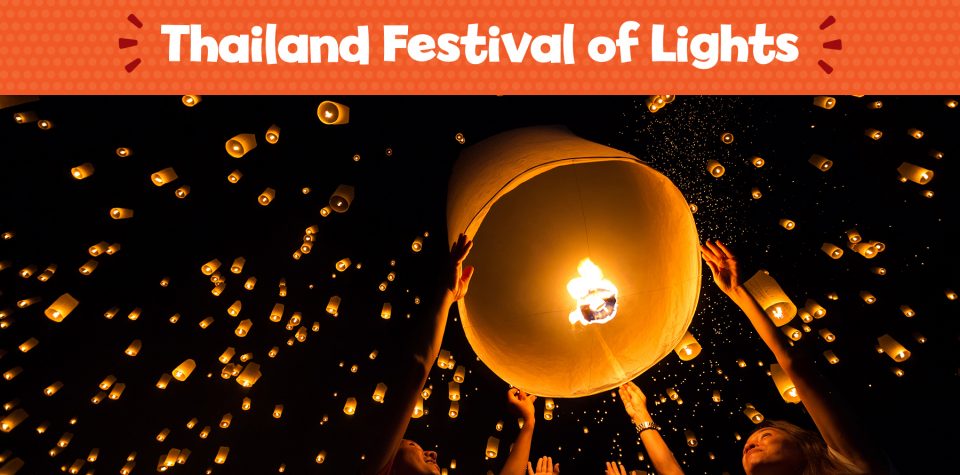
Thailand Festival of Lights
Every year in Thailand, fireworks crackle, candle-lit lanterns lift into the night air, and tiny rafts bearing candles—along with wishes, prayers, and woes—float away into the dark. This is the Thailand Festival of Lights!
Despite its name, the Thailand Festival of Lights is actually made up of two different festivals: Loi Krathong, the most widely celebrated throughout the country, and Yi Peng, which is commemorated in harmony with Loi Krathong, in Northern Thailand. The dates change every year, but because each one is determined by the full moon, they always occur at the same time—usually in November.
So, what are these festivals all about? Though their origins are unique, over time, they have come to share similar meanings.
Loi Krathong’s history is still up for debate, but many believe it started as a Brahman ritual which, over the centuries, evolved into a celebration of Buddha. During Loi Krathong, people create rafts called krathongs, made in the shape of open lotus flowers, the symbol of Buddhism. They are decorated with flowers, incense and candles. Traditionally, these vessels were made from banana leaves, but today you’re just as likely to see krathongs fashioned from bread!
 When evening falls, the maker of the krathong lights a candle and thinks of a wish or prayer before gently pushing it into the river. If the krathong disappears before the candle burns out, it’s believed that the wish comes true. Krathongs carry more than wishes! Oftentimes, celebrants place locks of hair into the baskets, believing they will whisk away bad luck.
When evening falls, the maker of the krathong lights a candle and thinks of a wish or prayer before gently pushing it into the river. If the krathong disappears before the candle burns out, it’s believed that the wish comes true. Krathongs carry more than wishes! Oftentimes, celebrants place locks of hair into the baskets, believing they will whisk away bad luck.
Traditional believers set a coin in the middle of the krathong as a tribute to the Thai goddess of the river, Phra Mae Khongkha. Because of this, festival-goers may hear the splish-splash of children diving in the water to fetch the coins before they float away!
Yi Peng is marked by the Lanna, or Northern Thai, calendar, and has always been a tribute to Buddha. Yi means “two,” or “second,” and Peng means “full moon,” so the holiday is always celebrated during the full moon of the second lunar month of the Lanna calendar. Instead of krathongs, lanterns take center stage in this festival! There are carrying lanterns that migrate from parades to temples, elegant hanging lanterns and vibrant spinning lanterns, and—most famously—the sky lanterns.
Known as khom loi, these sky lanterns mimic hot air balloons. Many people say a short prayer before lighting their khom loi, while others write notes or addresses onto the lanterns.
Because Chiang Mai celebrates both festivals, the city is regarded as one of the most spectacular places to partake in the festivities. Here, onlookers enjoy multiple days of events, which include beauty pageants, parades, fireworks, and, of course, the lighting of candles and lanterns. On the night of the full moon, the city is glowing with light, reflected in the water and sky. It’s a magical sight!
Learn more about Thailand by subscribing to our World Edition!

